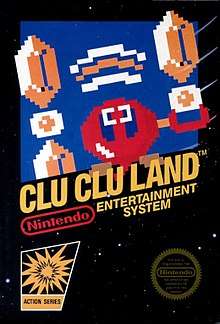Clu Clu Land
Clu Clu Land[lower-alpha 1] is an arcade and Nintendo Entertainment System game released in 1984 in Japan, later released in North America in 1985 as a Nintendo Entertainment System launch title, and in Europe in 1987. Nintendo has rereleased it many times via emulation.[3][4][5][6][7][5][8][9][5][10]
| Clu Clu Land | |
|---|---|
 | |
| Developer(s) | Nintendo R&D1 |
| Publisher(s) | Nintendo |
| Composer(s) | Akito Nakatsuka[1] |
| Platform(s) | Famicom/NES Arcade (Nintendo VS. System) Famicom Disk System Sharp Zaurus Game Boy Advance |
| Release | |
| Genre(s) | Puzzle |
| Mode(s) | Single-player, multiplayer |
Title
Although "Clu Clu Land" is the official English title for the game, "Clu Clu" is actually an anglicization of "Kuru Kuru"; a Japanese onomatopoeia that refers to something going "around and around". In order for Bubbles to move around the mazes, she must grab onto poles with her hands. When she holds on to a pole without letting go, she spins "around and around". The same phrase is also the basis for the title of the Game Boy Advance game Kuru Kuru Kururin.
Gameplay

In Clu Clu Land, the player is a female balloonfish named Bubbles, known as Gloopy[lower-alpha 2] in Japan, who swims around in a maze trying to uncover all the golden Ingots.[11]
The story starts with a type of sea urchin, the Unira, stealing all of the treasures in the underwater kingdom of Clu Clu Land. Bubbles, the heroine, sets out to retrieve the treasure. The object of the game is to uncover all the gold ingots in each stage while avoiding the Unira and Black Holes. Ingots usually form a shape such as a heart or a mushroom. The only way Bubbles can turn around to change directions is by means of Turning Posts located throughout the stages. She can stun the Unira by using a Sound Wave. When they are stunned, she can push them into a wall to get rid of them and receive points. If Bubbles is hurt by the Unira, she will lose a life. A life is also lost if she falls into a Black Hole, or if time runs out. The game ends when Bubbles has lost all her lives.
In later levels, the player must pass over the ingots an odd number of times to uncover them, as they will alternate between their uncovered side and a dull side.
Legacy
An expanded edition known as Vs. Clu Clu Land[lower-alpha 3] was released for the coin-op Nintendo Vs. System. It contains twice as many puzzles, a new enemy named Boss Unira, different level themes, and some other adjusted game features. A port of this version was released as the final game for the Family Computer Disk System, titled Clu Clu Land: Welcome to New Cluclu Land. It contains a few minor enhancements such as difficulty selection. Both the NES and FDS versions are unlockable in the GameCube game Animal Crossing, with the latter retitled Clu Clu Land D outside Japan.
In September 2001, the game was ported to the Sharp Zaurus series of PDAs.[2]
Various elements from Clu Clu Land appear throughout the Super Smash Bros. series. Bubbles appears as a trophy in Super Smash Bros. Melee, and the Unira enemy appears as an item is in its sequel, Super Smash Bros. Brawl, as well as Super Smash Bros. for Nintendo 3DS and Wii U, and Super Smash Bros. Ultimate. A medley of various tracks from the original game is selectable as background music for a number of stages in several games in the series, and Bubbles and Unira are featured as Spirits in Ultimate.
Bubbles is the last secret character in the Game Boy Advance game DK: King of Swing, which was inspired by Clu Clu Land.
WarioWare: Smooth Moves and WarioWare: Twisted! feature various minigames based on Clu Clu Land.
The Ingot sprite from Clu Clu Land is the same as the rupee in The Legend of Zelda (1986), which remains the currency unit in the series. The series' recurring Digdogger enemy is said to be a massive Unira. The bounce sound is the jump sound in Super Mario Bros. (1985).
Clu Clu Land is included in the NES Remix series. It was released for the Nintendo Switch in the eShop on June 28, 2018 by Hamster Corporation as part of the Arcade Archives series.[12]
See also
- List of NES games
Notes
References
- Famicom 20th Anniversary Original Sound Tracks Vol. 1 (Media notes). Scitron Digital Contents Inc. 2004.
- IGN staff (September 7, 2001). "CHIBI JAPAN WEEKLY 3". IGN. Retrieved November 23, 2014.
- "Clu Clu Land". Nintendo of America. Retrieved December 2, 2018.
- "VC クルクルランド" (in Japanese). Nintendo. Retrieved December 2, 2018.
- "Clu Clu Land". Nintendo of Europe GmbH. Retrieved December 2, 2018.
- "クルクルランド - ニンテンドー3DS - 任天堂" (in Japanese). Nintendo. Retrieved December 2, 2018.
- "Clu Clu Land". Nintendo. Retrieved December 2, 2018.
- "Clu Clu Land". Nintendo of America. Retrieved December 2, 2018.
- "クルクルランド". Nintendo. Retrieved December 2, 2018.
- Liam Doolan (May 7, 2019). "Nintendo Adds Three More Games To The Switch Online NES Library Next Week". Nintendo Life. Retrieved May 28, 2019.
- Brett Weiss (12 November 2012). Classic Home Video Games, 1985-1988: A Complete Reference Guide. McFarland. p. 180. ISBN 978-1-4766-0141-0.
- Lane, Gavin (2020-03-13). "Guide: Every Arcade Archives Game On Nintendo Switch, Plus Our Top Picks". Nintendo Life. Retrieved 2020-03-28.